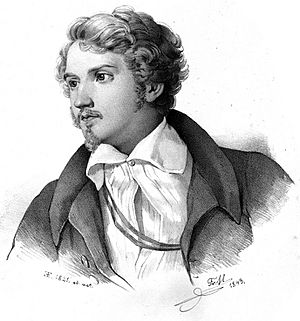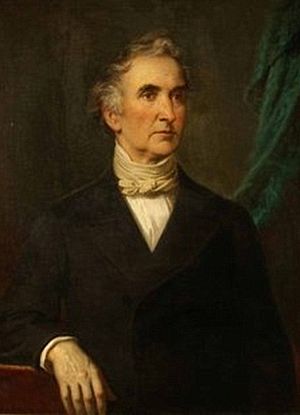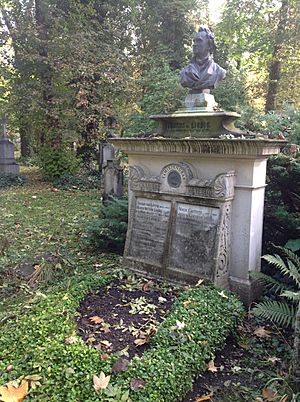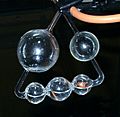Justus Liebig facts for kids
Quick facts for kids
Justus von Liebig
|
|
|---|---|

Justus von Liebig c. 1860
|
|
| Born | 12 May 1803 |
| Died | 18 April 1873 (aged 69) |
| Nationality | Hessian, then German |
| Alma mater | University of Bonn University of Erlangen |
| Known for | Invention of nitrogen-based fertiliser Law of the Minimum Liebig condenser |
| Scientific career | |
| Fields | Chemistry |
| Institutions | University of Giessen University of Munich |
Justus Freiherr von Liebig (born May 12, 1803 – died April 18, 1873) was a very important German chemist. He made huge contributions to how we understand agriculture and biological chemistry. Many people see him as the person who started the field of organic chemistry.
As a professor at the University of Giessen, he created a new way of teaching. He focused on students learning by doing experiments in a laboratory. Because of these new ideas, he is known as one of the best chemistry teachers ever.
Liebig is often called the "father of the fertilizer industry." He showed how important nitrogen and other tiny minerals are for plants to grow. He also came up with the law of the minimum. This law explains that plant growth depends on the nutrient that is hardest to find, not just the total amount of all nutrients.
He also invented a way to make beef extracts. A company called Liebig's Extract of Meat Company was started with his permission to sell this product. This company later created the famous Oxo brand beef bouillon cube. Liebig also helped make a tool called the Liebig condenser popular. This tool helps cool down vapors.
Liebig studied other foods too. He encouraged using baking powder to make bread lighter and fluffier. He also looked into the chemistry of making coffee. He even developed a special milk substitute for babies who couldn't drink breast milk. His discovery that yeast could be concentrated also helped lead to the invention of Marmite.
Early Life and Education
Justus von Liebig was born in Darmstadt, Germany. His father was a merchant who sold paints, varnishes, and pigments. He made these products in his own workshop. From a very young age, Justus was fascinated by chemistry.
When he was 13, Liebig experienced a very tough year. It was called "the year without a summer." Most food crops in the Northern Hemisphere were destroyed because of a volcanic winter. Germany was one of the countries hit hardest by the famine that followed. This experience is thought to have greatly influenced Liebig's later work. Thanks in part to his new ideas in fertilizers and farming, the 1816 famine became known as "the last great subsistence crisis in the Western world."
Liebig went to grammar school in Darmstadt. He left school without finishing. For a few months, he worked as an apprentice for an apothecary named Gottfried Pirsch. After that, he returned home and worked with his father for two years. Later, he went to the University of Bonn. There, he studied under Karl Wilhelm Gottlob Kastner, who was a business friend of his father. When Kastner moved to the University of Erlangen, Liebig followed him to continue his studies.
Later Life and Legacy
In 1852, King Maximilian II of Bavaria asked Justus von Liebig to join the Ludwig Maximilian University of Munich. Liebig also became a science advisor to the King. King Maximilian II wanted to make the University of Munich a top place for science research. Liebig accepted the job partly because, at 50, he found it harder to manage many students in the lab.
His new home in Munich showed his change in focus. It included a comfortable house for hosting guests. There was also a small laboratory and a new lecture hall for 300 people. This hall had a special lab at the front for demonstrations. He gave lectures to university students and public talks every two weeks. As a supporter of science, Liebig became president of the Bavarian Academy of Sciences and Humanities in 1858.
Justus von Liebig passed away in Munich in 1873. He is buried in the Alter Südfriedhof cemetery in Munich. His work continues to influence how we grow food and understand chemistry today.
Images for kids
See also
 In Spanish: Justus von Liebig para niños
In Spanish: Justus von Liebig para niños












